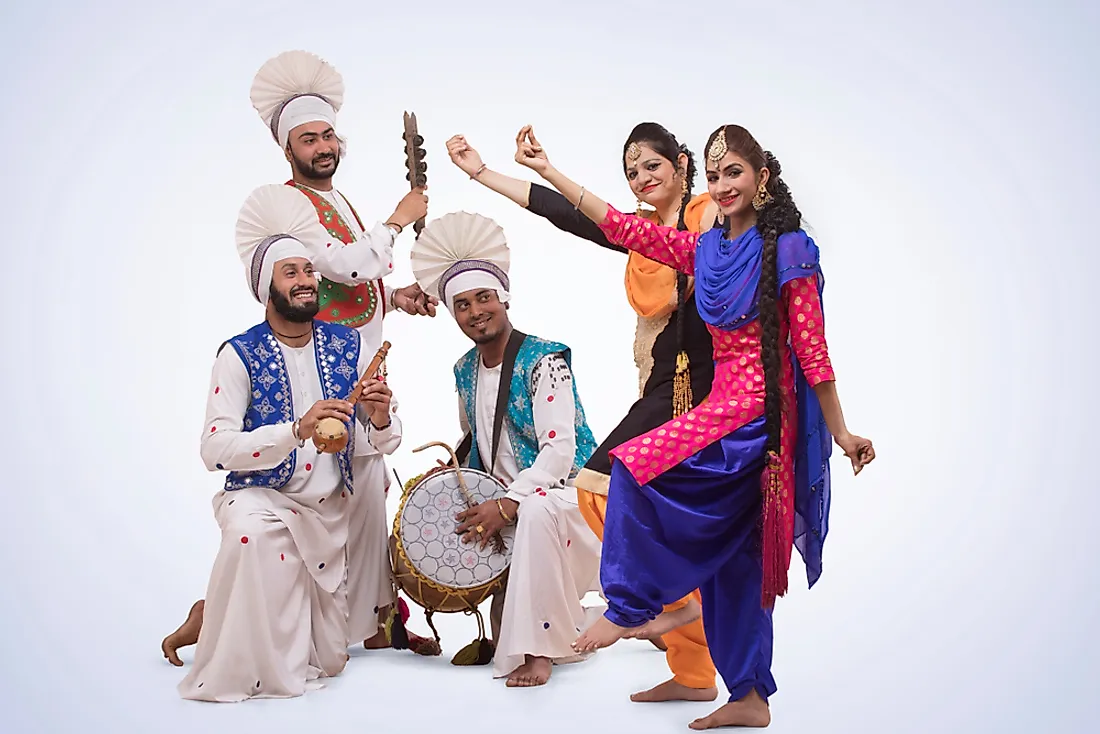What Is the Bhangra Dance Of Punjab?

5. Overview and Characteristics -
Bhangra is a traditional folk dance from the Punjab region of India and Pakistan. This dance is characterized by its use of Punjabi Boliyan lyrics, a style of couplet singing. Boliyan is used to express emotion over a specific situation, particularly love, money, and relationships. It is traditionally sung by women. Bhangra music may consist of many kinds of instruments, but it always contains the dhol drum. The dhol is a large, wooden barrel drum.
The dance itself is traditionally performed within a circle. Men and women dance to the rhythm of the dhol, although sometimes a dance may be only men or only women. It typically involves lots of arm and shoulder movements and is fast paced. Depending on the style, props such as sticks or swords may also be used.
Perhaps the most distinguishing feature of this dance is the style of clothing worn, which is always very bright and colorful. They are made to represent traditional clothing used in the rural areas of the Punjabi region. Men typically wear a turban, which is tied differently than the everyday turbans used by Sikh practitioners. They also wear very long loose shirts, called kurta, and baggy pants topped with a loincloth, called lungi. Over their shirts, men wear a jugi which is a waistcoat without buttons. Women wear a salwar kameez. This outfit consists of a pair of baggy pants that are tight around the ankle and a long, tunic-style shirt. They also wear a long scarf around their neck, called chunnis.
4. Origins -
As previously mentioned, this dance originated in the Punjab region of India. Beginning during the 20th Century, the Bhangra dance form was traditionally carried out as a means of celebrating the harvest. It grew in popularity in the middle years of the century and, in 1947, it was used to open the Baisakhi Festival, which is celebrated in April of each year. The dance later went on to become part of weddings and New Year celebrations.
3. Spread and Development -
Since Bhangra first became popular in the mid-1900s, it has undergone a number of significant changes. Today, people enjoy this dance both in Punjab and throughout Southeast Asia. It has become popular for celebrations, parties, and dance clubs. The musical style has also changed and now demonstrates a fusion of traditional Bhangra music with Western style pop and Hindi movie songs. Now Bhangra enthusiasts enjoy three types of the dance, including traditional, free form, and modern.
The free form style of Bhangra developed after independence was granted to India in 1947. The separation of India and Pakistan placed the majority of the Bhangra region in Pakistan. At the same time, Sikhs and Hindus left Pakistan to settle in Punjab, India. By the 1950’s, free form Bhangra had emerged here. A dance group was commissioned by the Maharaja to perform in 1953, which some consider the first free form performance. Free form continued as a dance style for the stage, incorporating traditional steps with moves from Luddi, Gham Luddi, Jhumar, and Dhamal dances. It grew in popularity throughout the 1950’s and by the 1970’s free form had established a relatively standard style. This style has been spread throughout the world by Punjabi emigrants.
Modern Bhangra developed in the 1990’s. This style combined traditional Bhangra steps with Western dance styles. The music is often a pre-recorded dance mix. It has become popular in international Punjabi communities and is often performed in competitions.
2. Notable Practitioners -
Some of the most well-known Bhangra performers are Inderjit Nikku, Jasbir Jassi, and Sukshinder Shinda. Inderjit Nikku is from the Ludhiana district of the Indian state of Punjab. Sukshinder Shinda is from Birmingham, England, and Jasbir Jassi is from Punjab in India.
1. Greater Significance and Legacy -
Bhangra is now a widely recognized dance that draws audiences and participants from all around the world. Its dance steps have been incorporated into workout routines and have been featured in festivals and competitions. The dance provides individuals with a common Punjabi background a way to express and honor their culture.











